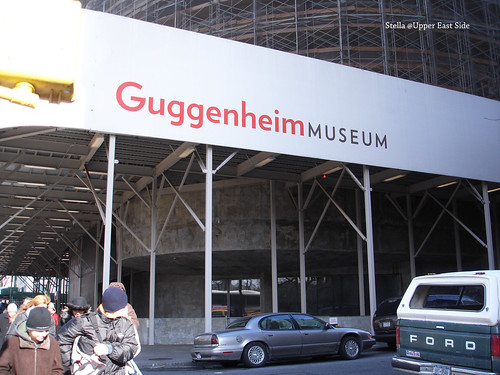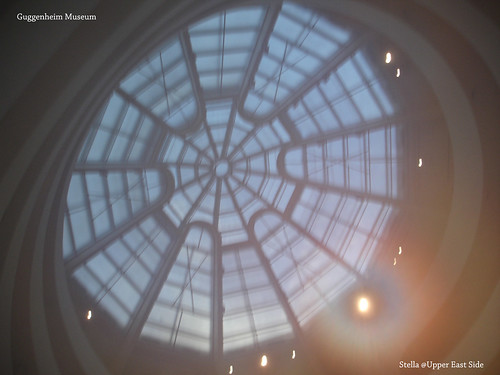close
這個月的26日,到位在上東城(Upper East Side)的古根漢博物館(Solomon R. Guggenheim Museum, New York)看西班牙繪畫特展:Spanish Painting from El Greco to Picasso--Time, Truth, and History。
特展中的畫作很豐富,規模相當大,從十六世紀的El Greco,到二十世紀的畢卡索(Pablo Picasso)、達利(Salvador Dalí)都在古根漢的斜坡展場裡,是美國地區少見的西班牙繪畫特展。這次的展覽不是以時間線編排,而以「主題(theme)」為線索,把不同時代的西班牙畫家相同主題的作品並置(juxtapose),讓觀者經由對照比較,進而理解不同時代西班牙繪畫的特色,了解相同主題在不同時代所蘊含的意義。畫展中的作品雖然不是以時間線規劃串連,但是在欣賞不同時代、相同主題的畫作時,觀者會在比較的過程中感受到西班牙繪畫的歷史演變,在這不以時間為經緯的展覽中感受到歷史性和時間性。
以下是從古根漢博物館網頁節錄的展覽概述:
Overview:
Spanish Painting from El Greco to Picasso: Time, Truth, and History brings together for the first time works by the great Spanish masters of the 16th through the 20th centuries: Francisco de Zurbarán, Diego Velázquez, Bartolomé Esteban Murillo, Francisco de Goya, Juan Gris, Salvador Dalí, Joan Miró, and many others, as well as El Greco and Pablo Picasso. Unlike other overviews that display paintings in a strictly chronological order, this exhibition is broken into fifteen distinct sections, each based on a theme running through the past five centuries of Spanish culture. These thematic axes highlight affinities between the art of the old masters and that of the modern era, and challenge conventional art histories that would seek to separate them. Accordingly, works from different periods appear side by side within each section, offering often radical juxtapositions that cut across time to reveal the overwhelming coherence of the Spanish tradition.
Until recently art historians bracketed Spanish painting between El Greco and Goya, maintaining that 20th-century avant-garde movements such as Cubism and Surrealism—both of which were pioneered by artists of Spanish origin—broke completely with the traditions that preceded them. Today we have sufficient historical perspective to see that, despite their revolutionary aesthetic leaps, the great artists of the early twentieth century were nourished by traditional models that were, furthermore, local in character. These models found their source in the Spanish School of the late-16th and 17th centuries, an era commonly regarded as the Golden Age of Spanish painting. The aesthetic styles developed during these years—from the visionary opulence of El Greco to the intimate naturalism of Velázquez—dominated artistic production in Spain throughout the following two-and-a-half centuries, as the nation's imperial power declined and Spain became increasingly isolated internationally. Even Goya, arguably the greatest Spanish painter of the 19th century, could break free from his forerunners only by looking them square in the eye; as the French romantic poet Théophile Gautier observed, "In his desire for artistic innovation, Goya found himself confronted by the old Spain."
By the late 19th century, following Goya and the spirit of romanticism, a national critical conscience had awoken in Spain's artists and intellectuals, but the country's antiquated political, social, and economic structures largely thwarted this modernizing impulse. This began a long period of exile or simple emigration, which marked the careers of all the 20th-century masters exhibited here. During this time many stereotypical treatments of recurring subjects that had formed in the wake of Spain's Golden Age were cast in a new light, as Europe rediscovered the art of the Spanish School and began to write its history for the first time. Chief among these characteristics was Spain's resolute anticlassicism, which was reflected in its timeless customs, its culture, and its art, and which came to be seen as a source of resistance to the overwhelming homogeneity associated with an industrialized, modern world. Thus as Spanish artists stigmatized the ideological clichés of traditional Spain, they also realized that formal innovation could only come if these same aesthetic values were brought up to date.
It is this endless return and reappropriation on a formal and iconographic level that binds together the works of Spanish artists, from Picasso, reaching back through Goya, to the masters of the Golden Age. These connections become especially apparent in particular themes of subject matter, whether established genres, such as still life, landscape, or portraiture, or apparently simple depictions of children, nudes, crucifixions, or domestic scenes. Each of these themes originates in the culture of 16th-century Spain, which was especially influenced by the Counter-Reformation, during which the Catholic Church reaffirmed its dogma, structure, and social role in response to the burgeoning threat of Protestantism. Despite this foundation in the past, the themes play out over the ensuing centuries, setting the basic terms for Spanish painting even as historical contexts and stylistic tendencies change dramatically.
(from Guggenheim Museum Official Website)
這個展覽會持續到三月二十八日,如果你剛好在紐約不妨去看一下。古根漢博物館很好找,就在第五大道和 89th St.交叉口,博物館的地址:
Solomon R. Guggenheim Museum
1071 Fifth Avenue (@89th St.)
New York, NY 10128-0173
看地圖
[開放的時間]
週六~週三 10am-5:45pm
週五 10am-7:45pm
(週四休館)
[交通方式]
強烈建議搭地鐵。搭#4, #5, 或#6 train到 [86th St.] 站下車,出站向西沿著 86th St.向西走至 Fifth Avenue,右轉,繼續向北走到 88th St.。
[票價]
購票即購買語音導覽,可以選擇自己習慣的語音導覽。如果沒記錯,有英文、日文、德文、法文(好像有,不確定);但是沒有中文。
成人(Adults) $18
學生和六十五歲以上長者(Students and Seniors 65 years+)出示有效證件 $15
12歲以下兒童 免費
古根漢會員 免費
星期五5:45pm之後,館方採「任意付(Pay What You Wish)」的售票方式,來參觀的人可以自行決定票價。要享受這「任意付(Pay What You Wish)」的人,最慢要在7:15pm購票入場。雖說是任意付,但是還是要付,不是免費。任意付的票要現場買,不可以上網預先購買。
[Stella的沒常識發現]
從語音導覽中得知,El Greco是Picasso的偶像!!Picasso的亞維濃姑娘(Les Demoiselles d'Avignon)就是受到El Greco的畫作The Opening of the Fifth Seal的影響。
嗯~文章已經太長了,今天就先講到這裡,改天再繼續。

全站熱搜





 留言列表
留言列表

